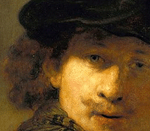
"The Parable of the Good Shepherd Separating the Sheep from the Goats"
Two early sixth-century mosaics depicting parables are found in the nave of the basilica Sant’Apollinare Nuovo in Ravenna, Italy (an early fifth-century mosaic of Jesus as the Good Shepherd is found in the mausoleum of Galla Placidia, also in Ravenna).
Among the mosaics on the north wall, barely discernible from the church’s floor, is a depiction of Matthew’s parable of the Sheep and Goats. The primary focus of the mosaic, in the middle of the image, is Jesus in a purple robe and seated on the judgment seat. Jesus’ halo also serves to distinguish him, since it includes a cross nimbus embedded with three blue jewels. His right hand is slightly raised, guiding our eyes to the three white sheep on his right. On his left (and our right) are three goats of darker color, and Jesus does not acknowledge their presence. The goats are placed at a level lower than are the three sheep on the other side of the panel, and they are placed closer together, which also highlights the greater importance of the sheep. Two angels stand beside Jesus, both with their right hands raised in blessing. The angel of Jesus’ right is clothed in orange and red, and his wings and halo are also orange and red. The clothes, wings, and halo of the angel on Jesus’ left are blue. Jesus stares straight ahead—into the eyes of the viewer, if the viewer were at the same level as the mosaic—which serves as a warning to viewers who call Jesus “Lord” but do not do what he commands them to do: feed the hungry, give drink to the thirsty, welcome the stranger, clothe the naked, and visit the imprisoned (Matt. 25:31-46; cf. Luke 6:46).